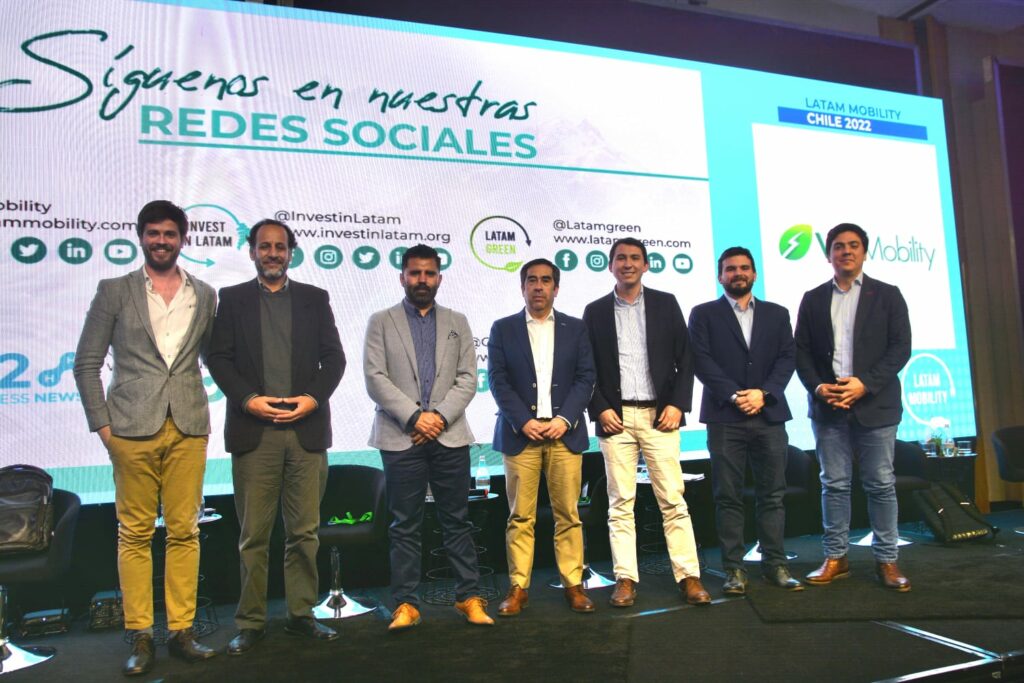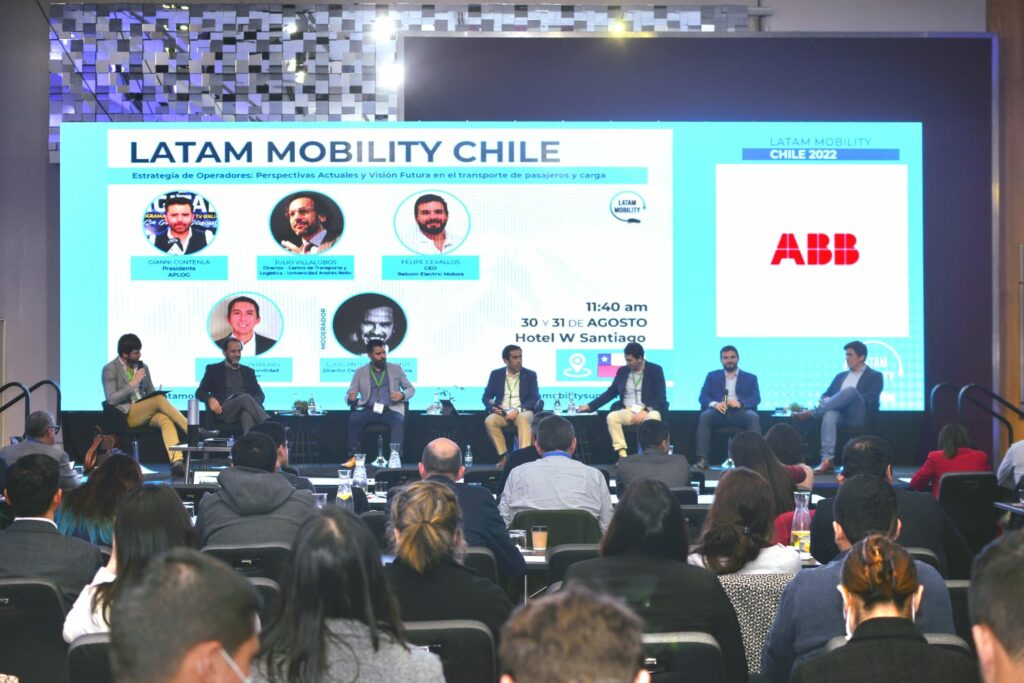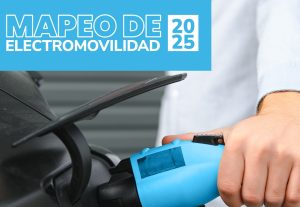Passenger and cargo transportation operations play a fundamental role in terms of sustainable mobility, because it is a sector that demands fuel in its operations and a large flow of vehicles to perform different functions, as well as new perspectives in their movements towards efficiency and being more environmentally friendly.
This topic had its space within the face-to-face meeting “Latam Mobility: Chile 2022“, through the panel: “Operator Strategy: Current Perspectives and Future Vision in passenger and cargo transportation“, which took place on August 31 at the W Santiago Hotel in the Chilean capital, under the organization of Latam Mobility, the leading community of sustainable mobility in Latin America.
The panel was attended by Gianni Contenla, President of the Association of Logistics Professionals (APLOG); Julio Villalobos, Director of the Center for Transportation and Logistics of the Andrés Bello University; Felipe Cevallos, CEO of Reborn Electric Motors; Cristian Contreras, Electromobility Manager at Andes Motor; Antonio Villalobos, Assistant Finance Manager at Buses Vule, and Rodrigo Troncoso, Sales and Marketing Manager at Arval Relsa Chile, under the moderation of Lluís Vidal, Business Development Director at VG Mobility.
Operational Challenges
Julio Villalobos, Director of the Center for Transportation and Logistics at the Andrés Bello University, explained that the role of the freight operator in the transition to electromobility is fundamental. “At the center we consider that there will not be a dominant energy as fossil fuels have been in the long term, but that the cargo operator will have the role of being able to manage various energies depending on the route and the operation, which means installing validation, monitoring, piloting competencies, to really know the needs.”
“The technological replacement presents important challenges. I think the main one is to generate available, broad evidence that allows us to have a serious discussion of the real impacts and benefits of this. The operator of the future will have to manage a pool of different energy technologies depending on which is the most appropriate in social, operational and environmental terms for each type of operation, since vehicles are assembled, they do not come preconfigured,” said Villalobos.
Regarding the challenges, Villalobos said: “There is a law to promote energy efficiency in Chile that wants to set efficiency standards for different vehicles, but when a different engine comes with different configurations to be operated in different geographical conditions, it is not possible to move towards a single understanding. The path is towards simulations of performance in different operational configurations and try to have everything in a certain radius, with the help of many technologies.”
Integration
Regarding the role of operators, Gianni Contenla, APLOG President, pointed out the needs for efficiency in freight transportation. “We have an efficiency problem and we must not only focus on the shift towards e-mobility, but also on the way we manage it. Post-COVID, since March 2020 last mile sales increased, so we have had to increase the last mile fleet, which increases vehicle congestion, and associated delays. We must be increasingly efficient, with faster delivery points, to minimize the widespread pollution in the metropolitan region.”
For Contenla, one of the main challenges is education. “There is no education in terms of electromobility because technology is going faster than we are going. We don’t have people prepared to be able to meet the needs, so I think the key words could be: education, integration and synergy with the State, industry, academia and guilds. In general, the whole citizenry has to be integrated”.

Living the Ecosystem
For his part, Rodrigo Troncoso, Sales and Marketing Manager of Arval Relsa Chile, explained that his organization manages one and a half million cars in property, of which 240,000 are electric. “We want to reach 2025 with 700,000 EVs and that is where our task of incorporating large fleets and making them efficient in the city starts, but we have to provide a comprehensive service, including the charging network. We have to think first about the cost of this company to be able to offer something that has an impact and a benefit for the user and for the end consumer”.
In relation to the barriers, the Arval executive said that in this ecosystem the different modes of transport of different technologies and uses will have to be integrated. “Chile is four thousand kilometers long and when I present it to the factory or head office in France they do not understand how you travel 4,000 kilometers. We have received buses without bathrooms to travel more than 300 kilometers, they do not understand that they are different routes, different concepts, and our task is to transmit that to the manufacturer’s side.”
“We are a country of 400,000 vehicles a year with a population of 19 million inhabitants, so it is difficult to put that pressure so that we have a final product that satisfies all this. I think the invitation is to live in this ecosystem and think about the future, what is the proposal that we can make from this side as operators, as fleet managers,” Troncoso stressed.
Building the Foundations
Cristian Contreras, Electromobility Manager at Andes Motor pointed out that “the operator must build the foundations to start developing electromobility. We are at a very early stage, which we have to take advantage of to build it under solid foundations. This strategy is fundamental, to listen, understand and evaluate the needs they have for the implementation of electric fleets, especially because there are different use cases.”
“There are different characteristics and particularities that each of the segments have, and fundamental roles, as in the particular case of public transport in Santiago where they are very intensive in the use of mileage, with lower variable operating costs, the operational expenditure is cheaper and allows to compensate these higher costs of electric vehicles that are a challenge for operators. There is a genuine reason for wanting to decarbonize and decrease footprints, so you have to make these assessments to offer solutions that fit the need of the operators,” he explained.
Following the line of benefits for brands, the Andes Motor representative said that “it is a path we are starting to walk, but there is still a lot to learn. The benefits are positive, although there are also a number of additional challenges, such as the training of technicians to attend these vehicles and that they can be throughout the country, including the training of emergency people. There are a number of things to satisfy in order for this implementation to be sustainable in the long term and to help decarbonization.”
More Competitiveness
Felipe Cevallos, CEO of Reborn Electric Motors considers that operators are key given that they are the ones who make the connection, request transportation and generate projects to integrate electromobility. “For example, in the case of Transantiago in 2017, the ministry wanted to bring electric vehicles and they studied with the manufacturers how to mitigate risk, maintenance and so they were able to implement these electric solutions, which today has more than 1,000 buses in Chile. Operators play a very important role in implementing these solutions.
Cevallos gave the example of electromobility in the mining sector. “We have seen that electric vehicles bring a series of benefits that were not considered at the beginning, for example, in terms of safety, regenerative braking makes it much safer to operate on slopes, and helps the driver to have much more control. In addition, we have seen that the staff is lining up to enter the electric buses because after 10 to 12 hour shifts, they prefer to return home in a quieter and more comfortable bus, it is a more pleasant experience”.
Regarding the barriers, the CEO of Reborn Electric said that the main one is to make the total cost of the project more competitive. “There are three pillars to solve in order to break that barrier: the first is the lack of experience in the market, the second is the resale value of the buses, and the third is how an electric project differs from a diesel one. Today there is not so much empirical data on how they work, but this will be solved with the entry of more buses into the country, since more data will be generated. And also, try to generate slightly larger contracts that cover the risk of resale price so that the operating price of the electric one compensates for it”.
Operators’ Vision
For his part, Antonio Villalobos, assistant finance manager of Buses Vule, indicated that its fleet travels 80 million kilometers per year, and compared to emissions, there is a great responsibility. “The operator plays a very important role in supporting the authorities and providing information to make this change. We have been accumulating data in some services for more than five years and it has contributed to continue advancing in this energy transition.”
Regarding the benefits of electric mobility, Villalobos said that “as an operator there was initial uncertainty, but we are seeing benefits that were also unknown. In terms of operational costs we see relevant improvements from the use of energy versus fuel, as well as in terms of maintenance, which are less complex operations than in the conventional bus”.
As a public transport operator, the Buses Vule representative said that the biggest challenge is to deliver a quality service to contribute to the change in the modal split in how we move in our cities. “I think it is key that we understand electromobility as a tool, as well as the challenges it has, such as operational, residual values or alternative markets for certain components, infrastructure costs, financing which is not minor, and training of drivers and maintenance area personnel. We have to see how we schedule to make all this fit together.

The following is day 2 of “Latam Mobility: Chile 2022“




